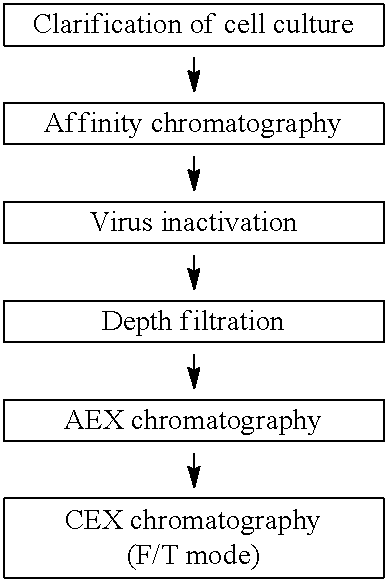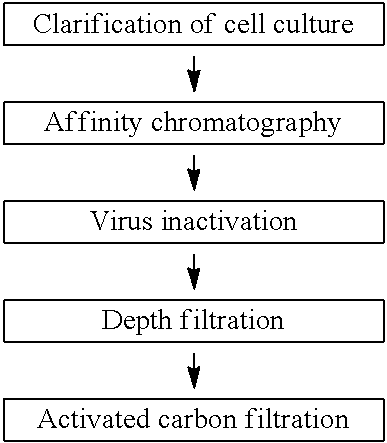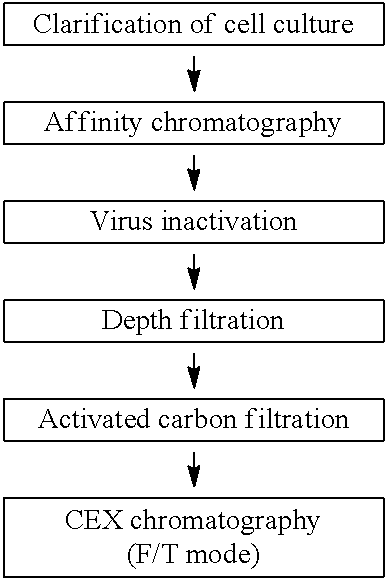Methods for purifying antibodies comprising of a process by using activated carbon materials
a technology of activated carbon materials and purification steps, which is applied in the direction of separation processes, peptides, cation exchanger materials, etc., can solve the problems of increased production costs, adverse effects on safety and efficacy, and not only antigenic, so as to eliminate aex chromatography, reduce the impurity load on the subsequent purification step, and eliminate the effect of aex chromatography
- Summary
- Abstract
- Description
- Claims
- Application Information
AI Technical Summary
Benefits of technology
Problems solved by technology
Method used
Image
Examples
example 1
sed in Common
[0164]In this Example, methods, which are used in common in Example 2 and subsequent Examples, will be described.
[0165]1) Measurement of Antibody Concentration
[0166]Antibody concentration was measured by HPLC using PA ID Sensor Cartridge (2.1 mm×3 mm, Applied Biosystems) column.
[0167]2) HCP Measurement
[0168]HCP was measured by use of third-generation CHO host cell protein kit from Cygnus Technologies or CH01360 HCP ELISA kit from BioGENES GmbH in accordance with enzyme-linked immunosorbent assay (ELISA). The HCP concentration obtained was converted to a value ng HCP / mg antibody by dividing it by the antibody concentration.
[0169]In Examples 2 to 5, the third-generation CHO host cell protein kit from Cygnus Technologies was used; whereas in Examples 6 to 8, CH01360 HCP ELISA kit from BioGENES GmbH was used.
[0170]3) PLBL2 Measurement
[0171]PLBL2 was measured by use of Hamster Phospholipase B-Like 2 (PLBL2) ELISA kit from Immunology Consultants Laboratory, INC. in accordance...
example 2
Example: Purification by CEX Chromatography in F / T Mode (Mab A)
[0180]In this Example, clearance of impurities in a purification flow of a monoclonal antibody referred to as Mab A will be described in accordance with the flowchart shown in Table 1 below.
TABLE 1
[0181]1) Materials and Methods
[0182]The cell culture containing Mab A produced by CHO cells was filtered with a depth filter to remove the cells and subjected to clarification to obtain a cell culture supernatant. The cell culture supernatant was purified by protein A chromatography using KanCapA resin. After the column was equilibrated with a phosphate buffer (pH 7.5) containing 20 mM sodium chloride, the cell culture supernatant was loaded. Thereafter, the column was washed with a phosphate buffer (pH 7.5) containing 1 M sodium chloride and subsequently with a phosphate buffer (pH 7.5) containing 20 mM sodium chloride. Mab A was eluted from the column with an acetate buffer (pH 3.6). The absorbance at 280 mm was monitored and...
example 3
of Impurities by Activated Carbon Material (Mab A, Mab B, Mab C, Mab D)
[0185]In this Example, clearance of impurities in a purification flow of a multiple antibodies referred to as Mab A, Mab B, Mab C and Mab D will be described in accordance with the purification flowchart shown in Table 3 below. Note that, the amino acid sequences of Mab A, Mab B, Mab C and Mab D, and antigens to be bound are mutually different.
TABLE 3
[0186]1) Clearance of Impurities (Except Viruses) by Activated Carbon Material
[0187]Millistak+® Pod CR40 was used as the activated carbon material. Mab B and Mab A were evaluated for antibody recovery rate and clearance of impurities. The depth filtration pools of Mab B and Mab A obtained in accordance with the method shown in Example 2 were each used as a loading solution (activated carbon material load) to an activated carbon filter. Note that, in the case of Mab B, to facilitate evaluation of clearance performance of the activated carbon filter to remove HCP, wash...
PUM
| Property | Measurement | Unit |
|---|---|---|
| pH | aaaaa | aaaaa |
| pH | aaaaa | aaaaa |
| electrical conductivity | aaaaa | aaaaa |
Abstract
Description
Claims
Application Information
 Login to View More
Login to View More - R&D
- Intellectual Property
- Life Sciences
- Materials
- Tech Scout
- Unparalleled Data Quality
- Higher Quality Content
- 60% Fewer Hallucinations
Browse by: Latest US Patents, China's latest patents, Technical Efficacy Thesaurus, Application Domain, Technology Topic, Popular Technical Reports.
© 2025 PatSnap. All rights reserved.Legal|Privacy policy|Modern Slavery Act Transparency Statement|Sitemap|About US| Contact US: help@patsnap.com



